Depei Qian
Beyond Window-Based Detection: A Graph-Centric Framework for Discrete Log Anomaly Detection
Jan 21, 2025



Abstract:Detecting anomalies in discrete event logs is critical for ensuring system reliability, security, and efficiency. Traditional window-based methods for log anomaly detection often suffer from context bias and fuzzy localization, which hinder their ability to precisely and efficiently identify anomalies. To address these challenges, we propose a graph-centric framework, TempoLog, which leverages multi-scale temporal graph networks for discrete log anomaly detection. Unlike conventional methods, TempoLog constructs continuous-time dynamic graphs directly from event logs, eliminating the need for fixed-size window grouping. By representing log templates as nodes and their temporal relationships as edges, the framework dynamically captures both local and global dependencies across multiple temporal scales. Additionally, a semantic-aware model enhances detection by incorporating rich contextual information. Extensive experiments on public datasets demonstrate that our method achieves state-of-the-art performance in event-level anomaly detection, significantly outperforming existing approaches in both accuracy and efficiency.
Quantum Machine Learning in Log-based Anomaly Detection: Challenges and Opportunities
Dec 18, 2024Abstract:Log-based anomaly detection (LogAD) is the main component of Artificial Intelligence for IT Operations (AIOps), which can detect anomalous that occur during the system on-the-fly. Existing methods commonly extract log sequence features using classical machine learning techniques to identify whether a new sequence is an anomaly or not. However, these classical approaches often require trade-offs between efficiency and accuracy. The advent of quantum machine learning (QML) offers a promising alternative. By transforming parts of classical machine learning computations into parameterized quantum circuits (PQCs), QML can significantly reduce the number of trainable parameters while maintaining accuracy comparable to classical counterparts. In this work, we introduce a unified framework, \ourframework{}, for evaluating QML models in the context of LogAD. This framework incorporates diverse log data, integrated QML models, and comprehensive evaluation metrics. State-of-the-art methods such as DeepLog, LogAnomaly, and LogRobust, along with their quantum-transformed counterparts, are included in our framework.Beyond standard metrics like F1 score, precision, and recall, our evaluation extends to factors critical to QML performance, such as specificity, the number of circuits, circuit design, and quantum state encoding. Using \ourframework{}, we conduct extensive experiments to assess the performance of these models and their quantum counterparts, uncovering valuable insights and paving the way for future research in QML model selection and design for LogAD.
LogGPT: Exploring ChatGPT for Log-Based Anomaly Detection
Sep 03, 2023



Abstract:The increasing volume of log data produced by software-intensive systems makes it impractical to analyze them manually. Many deep learning-based methods have been proposed for log-based anomaly detection. These methods face several challenges such as high-dimensional and noisy log data, class imbalance, generalization, and model interpretability. Recently, ChatGPT has shown promising results in various domains. However, there is still a lack of study on the application of ChatGPT for log-based anomaly detection. In this work, we proposed LogGPT, a log-based anomaly detection framework based on ChatGPT. By leveraging the ChatGPT's language interpretation capabilities, LogGPT aims to explore the transferability of knowledge from large-scale corpora to log-based anomaly detection. We conduct experiments to evaluate the performance of LogGPT and compare it with three deep learning-based methods on BGL and Spirit datasets. LogGPT shows promising results and has good interpretability. This study provides preliminary insights into prompt-based models, such as ChatGPT, for the log-based anomaly detection task.
FamilySeer: Towards Optimized Tensor Codes by Exploiting Computation Subgraph Similarity
Jan 01, 2022
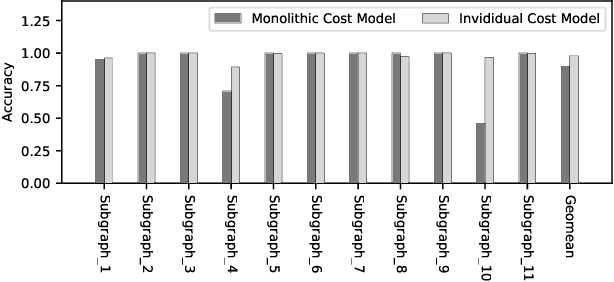
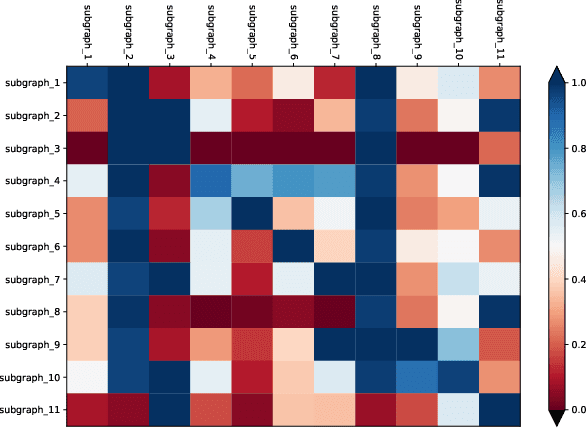

Abstract:Deploying various deep learning (DL) models efficiently has boosted the research on DL compilers. The difficulty of generating optimized tensor codes drives DL compiler to ask for the auto-tuning approaches, and the increasing demands require increasing auto-tuning efficiency and quality. Currently, the DL compilers partition the input DL models into several subgraphs and leverage the auto-tuning to find the optimal tensor codes of these subgraphs. However, existing auto-tuning approaches usually regard subgraphs as individual ones and overlook the similarities across them, and thus fail to exploit better tensor codes under limited time budgets. We propose FamilySeer, an auto-tuning framework for DL compilers that can generate better tensor codes even with limited time budgets. FamilySeer exploits the similarities and differences among subgraphs can organize them into subgraph families, where the tuning of one subgraph can also improve other subgraphs within the same family. The cost model of each family gets more purified training samples generated by the family and becomes more accurate so that the costly measurements on real hardware can be replaced with the lightweight estimation through cost model. Our experiments show that FamilySeer can generate model codes with the same code performance more efficiently than state-of-the-art auto-tuning frameworks.
The Deep Learning Compiler: A Comprehensive Survey
Feb 27, 2020



Abstract:The difficulty of deploying various deep learning (DL) models on diverse DL hardware has boosted the research and development of DL compilers in the community. Several DL compilers have been proposed from both industry and academia such as Tensorflow XLA and TVM. Similarly, the DL compilers take the DL models described in different DL frameworks as input, and then generate optimized codes for diverse DL hardware as output. However, none of the existing survey has analyzed the unique design of the DL compilers comprehensively. In this paper, we perform a comprehensive survey of existing DL compilers by dissecting the commonly adopted design in details, with emphasis on the DL oriented multi-level IRs, and frontend/backend optimizations. Specifically, we provide a comprehensive comparison among existing DL compilers from various aspects. In addition, we present detailed analysis of the multi-level IR design and compiler optimization techniques. Finally, several insights are highlighted as the potential research directions of DL compiler. This is the first survey paper focusing on the unique design of DL compiler, which we hope can pave the road for future research towards the DL compiler.
Privacy for Rescue: A New Testimony Why Privacy is Vulnerable In Deep Models
Dec 31, 2019



Abstract:The huge computation demand of deep learning models and limited computation resources on the edge devices calls for the cooperation between edge device and cloud service by splitting the deep models into two halves. However, transferring the intermediates results from the partial models between edge device and cloud service makes the user privacy vulnerable since the attacker can intercept the intermediate results and extract privacy information from them. Existing research works rely on metrics that are either impractical or insufficient to measure the effectiveness of privacy protection methods in the above scenario, especially from the aspect of a single user. In this paper, we first present a formal definition of the privacy protection problem in the edge-cloud system running DNN models. Then, we analyze the-state-of-the-art methods and point out the drawbacks of their methods, especially the evaluation metrics such as the Mutual Information (MI). In addition, we perform several experiments to demonstrate that although existing methods perform well under MI, they are not effective enough to protect the privacy of a single user. To address the drawbacks of the evaluation metrics, we propose two new metrics that are more accurate to measure the effectiveness of privacy protection methods. Finally, we highlight several potential research directions to encourage future efforts addressing the privacy protection problem.
CompactNet: Platform-Aware Automatic Optimization for Convolutional Neural Networks
May 28, 2019



Abstract:Convolutional Neural Network (CNN) based Deep Learning (DL) has achieved great progress in many real-life applications. Meanwhile, due to the complex model structures against strict latency and memory restriction, the implementation of CNN models on the resource-limited platforms is becoming more challenging. This work proposes a solution, called CompactNet\footnote{Project URL: \url{https://github.com/CompactNet/CompactNet}}, which automatically optimizes a pre-trained CNN model on a specific resource-limited platform given a specific target of inference speedup. Guided by a simulator of the target platform, CompactNet progressively trims a pre-trained network by removing certain redundant filters until the target speedup is reached and generates an optimal platform-specific model while maintaining the accuracy. We evaluate our work on two platforms of a mobile ARM CPU and a machine learning accelerator NPU (Cambricon-1A ISA) on a Huawei Mate10 smartphone. For the state-of-the-art slim CNN model made for the embedded platform, MobileNetV2, CompactNet achieves up to a 1.8x kernel computation speedup with equal or even higher accuracy for image classification tasks on the Cifar-10 dataset.
swTVM: Exploring the Automated Compilation for Deep Learning on Sunway Architecture
Apr 18, 2019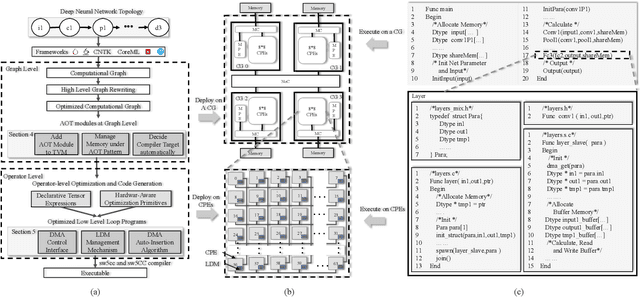
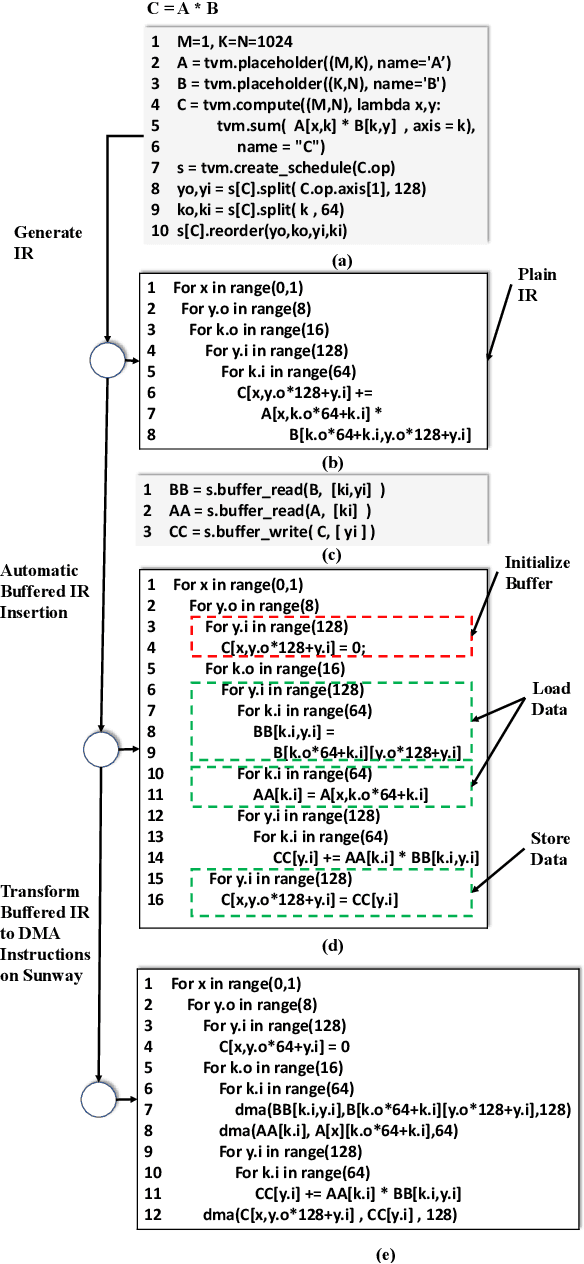
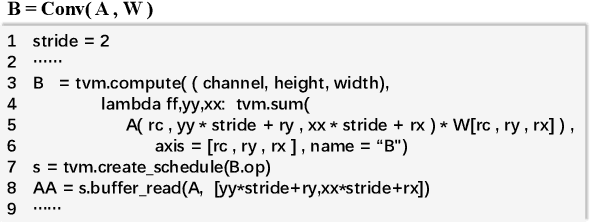
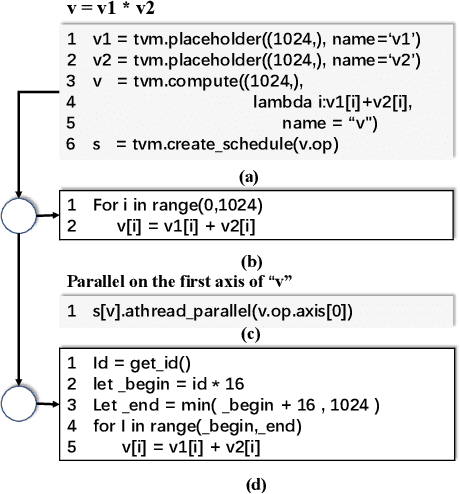
Abstract:The flourish of deep learning frameworks and hardware platforms has been demanding an efficient compiler that can shield the diversity in both software and hardware in order to provide application portability. Among the exiting deep learning compilers, TVM is well known for its efficiency in code generation and optimization across diverse hardware devices. In the meanwhile, the Sunway many-core processor renders itself as a competitive candidate for its attractive computational power in both scientific and deep learning applications. This paper combines the trends in these two directions. Specifically, we propose swTVM that extends the original TVM to support ahead-of-time compilation for architecture requiring cross-compilation such as Sunway. In addition, we leverage the architecture features during the compilation such as core group for massive parallelism, DMA for high bandwidth memory transfer and local device memory for data locality, in order to generate efficient code for deep learning application on Sunway. The experimental results show the ability of swTVM to automatically generate code for various deep neural network models on Sunway. The performance of automatically generated code for AlexNet and VGG-19 by swTVM achieves 6.71x and 2.45x speedup on average than hand-optimized OpenACC implementations on convolution and fully connected layers respectively. This work is the first attempt from the compiler perspective to bridge the gap of deep learning and high performance architecture particularly with productivity and efficiency in mind. We would like to open source the implementation so that more people can embrace the power of deep learning compiler and Sunway many-core processor.
 Add to Chrome
Add to Chrome Add to Firefox
Add to Firefox Add to Edge
Add to Edge